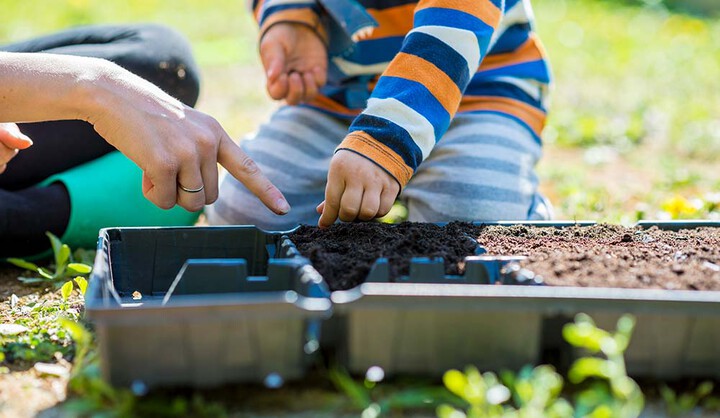Gardening with kids can be both fun and rewarding. Pretty much from the time they can walk, kids can help out in the garden. They can dig, plant, water and share in the joy of watching something flourish that they helped plant. Share your love of gardening with the children in your life – the Gilmour guide makes it easy.

·Benefits of Gardening with Children
·How to Get Children Interested in Gardening
·What Plants Should Children Grow
·Kids Gardening Tools – Picking the Right Equipment
·Kids Gardening FAQ
Benefits of Gardening with Children
Just like adults, children benefit from working in the garden. In addition to the fact that they are outdoors, soaking up the vitamin D and getting fresh air, there are benefits like fine motor skill development when digging and pulling, and cognitive skills develop while communicating about planning the logistics of a garden. Gardening promotes social skills as well. Discussing and agreeing on tasks, asking questions and learning more information about plants are all key elements of why gardening is such a great job to share with the little people in your life.
Children enjoy being involved with a garden from the ground up, at every stage from planting to picking. They love sharing in the responsibilities of watering, keeping the garden tidy and weed-free and even working together to get chores done more quickly.
How to Get Children Interested in Gardening
Most kids will flock to the idea of helping in the garden. They love being with the adults in their life and it is natural for them to want to emulate the jobs they see those adults doing.
There are a few ways to encourage and promote interest, though. After visiting local farms, gardens and nurseries, check out seasonal farmers’ markets so kids can see firsthand what they will be growing. To avoid frustration and keep them engaged, be sure to:
· Keep tasks age-appropriate and simple.
· Let older children be a part of the planning process.
· Find tools and equipment that are a smaller size and fit.
· Don’t limit tasks to digging in the dirt – creative children will enjoy making scarecrows, designing plant identifier tags and building or setting up bird baths and sundials.
· Let them play – making mud pies is a surprisingly fun activity that kids young and old genuinely love.
· Assign tasks after the planting is done – charting growth, checking for and pulling weeds and watering are all great jobs that little hands can help with.
· Think about the end result – grow plants of different sizes and shapes and let kids marvel at the wonder of how unique they all are. Sunflowers growing high into the sky, squash sprawling wildly and beans and cucumbers growing on teepee-like structures are all fun for kids to watch as they grow.
· Set up a worm farm and discuss how important worms are to the garden and soil.
· Start a compost pile and put kids in charge of collecting kitchen scraps and yard trimmings.
What Plants Should Children Grow
Some plants are easier to grow than others, making them a better choice for planting with kids. Find a combination of bright fun flowers, strongly-scented plants and tasty quick-growing vegetables and herbs that will sprout soon after planting to keep kids interested and excited. There are many plants for kids out there that will peak (and keep!) their interest all season long.
Kids Gardening Tools – Picking the Right Equipment
There are so many things little hands can help with in the garden. From digging to harvesting and everything in between, kids are eager to be put to work. Make sure they are set up for success with the right tools and equipment.
Find gloves that fit and smaller versions of trowels, rakes, watering cans, spades and hoes. Children practice and develop both cognitive and fine motor skills when they put tools to work. Without even knowing it, they are developing coordination.
Kids Gardening FAQ
How big should a kids garden be?
There is no one right answer in regard to how big a kids’ garden should be. That said, anything too big may feel daunting or overwhelming to a very young child. First-time gardens can be perfectly sized in a 3’x3’ space. Keep in mind, you can grow a much bigger garden if desired. Just identify with children which space is “theirs.”
What age should children learn to garden?
Any toddler can help in the garden. From the time they can sit up, they can be happy sitting with you any time you are working in the yard.
Should children teach other children to garden?
Children can help teach others about gardening. Each year they are out in the garden, they will learn something new. And what a thrill for them to be able to then share their knowledge with peers and others. Of course, an adult should always supervise the “teaching” sessions.
Can children learn about the environment by gardening?
Children can learn lifelong lessons about the environment by gardening. They learn about the life cycles of living things and how important water, sunlight and seasons are to our world. They gain respect for our planet. Intrinsic messages and lessons we can teach when gardening with kids include:
·how important it is to take care of the earth and not litter
·how much we can gain from composting and recycling
·how valuable being resourceful can be
Gardening with kids can bring a new sense of joy to even those mundane tasks that may not be your favorite. The wonder and delight children get from watching something they planted grow…it may just make you feel like a kid again too!